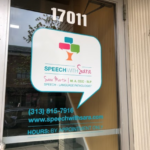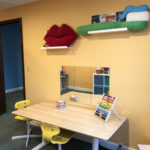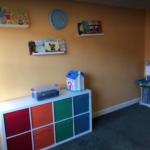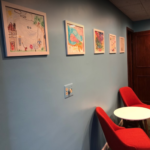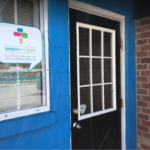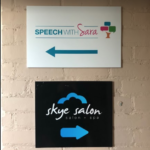The new clinic space is coming along! Will be having my first session in the office this week and I’m so excited!
Up Next: Moving into the Village
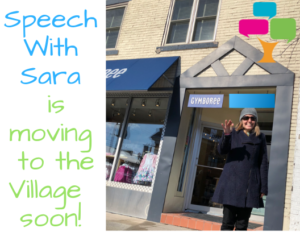
I’m moving! It’s finalized and I picked up the keys today!
In the coming months I’ll be working to ready this new office space located in the Village business and shopping district of Grosse Pointe. I’m above the children’s clothing store Gymboree and next to Skye Salon.
Stay tuned for updates and some sneak peeks of the new office!
The Surprise In My Mailbox: ASHA ACE Award
I love to learn and I’m in a profession that requires continual education. This relationship works out well.
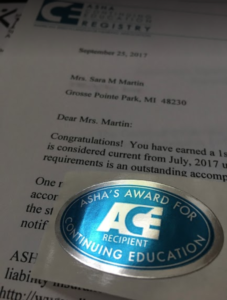
I am doing professional development and continuing education courses all the time. Some I complete in a webinar format or online series. For others I travel and spend several days learning during in-person workshops.
There is a lot of reading too–catching up on research in the f
ield and working to apply research results to therapy sessions.
It’s one the parts of being a speech-language pathologist. There are opportunities to learn and grow. Sometimes I select courses based on my own areas of passion within the field: literacy, early childhood language, etc. Other times, I select courses based on client needs and circumstances.
It was to my great surprise, however, that today I found an award in my mailbox. I received recognition for not only completing the required number of hours but for far exceeding them.
The American Speech Language Hearing Association ACE Award is issued to those who complete more than double the number of required hours within a 36-month period.
While I know I complete a great deal of continuing education, I had no idea I was earning this award and it was a rather exciting find in the mailbox!
10 Ways to Help Develop Speech & Language Skills
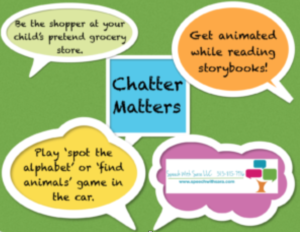 There are ways to help your child develop speech and language skills way before they are actually talking to you. Children learn through their every day environment–that means from their interactions with you, extended relatives, siblings, babysitters and other caregivers. They learn through play with people and toys. Babies start learning the turn-taking nature of conversation when someone responds to their cries, their coos and babbles and even during a good game of peekaboo with a blanket or hands.
There are ways to help your child develop speech and language skills way before they are actually talking to you. Children learn through their every day environment–that means from their interactions with you, extended relatives, siblings, babysitters and other caregivers. They learn through play with people and toys. Babies start learning the turn-taking nature of conversation when someone responds to their cries, their coos and babbles and even during a good game of peekaboo with a blanket or hands.
Some of the ideas below may sound obvious, but in today’s busy family climate, sometimes the basics of communication fall to the wayside in the hustle and bustle of every day life.
Talk to your child every day. Talk about what you’re doing, about what your child is doing, about your location, places and things you see during travel or while shopping. Treat babbling from a baby as communication and respond to it.
Engage in conversation with your child. When they ask a question, offer expanded information about the topic. Repeat their phrases and add more to it. This is a strategy of expansion and extension in which children learn the structure of language as well as context and vocabulary.
Model strong non-verbal communication skills, such as eye-contact, turn-taking in conversation/games, facial expressions and intonation. This helps children learn how to interpret and react to the non-verbal elements of communication, such as body language.
Read to your child every day. Establish a routine early and stick to it. Of course there will be days when this is not an option but make those the exception rather than the norm. Reading aloud exposes children to a variety of vocabulary. It helps children build & improve their joint attention skills, learning/understanding of language and helps with speech-sound development.
Picture books provide a context and tangible reference for children to the language that is being shared in the story for younger children. Continue to read aloud to children after they’ve started reading on their own. This enhances their vocabulary, their understanding of the characters, the story elements, their own reading fluency, their understanding of humor and idioms, and more.
During reading, take time to stop and talk about different parts of the book or to explain a new vocabulary word. In explaining new words, relate it to something familiar for your child. Provide them the definition as well as an example. Providing both leads to better comprehension of the concept.
Visit and explore different places—inside and out. Go the local library and check out books (or read some there). Go grocery shopping together. Have a picnic at the park. Take a walk in your neighborhood when it’s raining or snowing. Visit the zoo. Paint outside. These are great opportunities in which conversation happens naturally and robustly.
Play board, card and other low-tech games. There is a lot of quality communication that happens during traditional game-playing, which helps children learn pragmatic (social communication) skills. It also teaches skills such as turn-taking, how to be a graceful winner/loser, as well as improving executive function skills such as organization, strategy and memory.
Engage in pretend play. Be the shopper at your child’s grocery store; the customer at their restaurant; or the sick patient in their doctor’s office. This provides children with a great opportunity to practice their speech and language skills and to hear a great model of appropriate speech and language from you. It also allows concepts with which children are already familiar to be expanded upon, building their semantic network. They also learn reciprocal communication skills.
Make a variety of toys and books available. Open-ended toys (those that don’t come to a clear end) are great for generating conversation. Examples include: blocks, play kitchen, a toy farm/house, cars, dolls, etc. Close-ended toys, such as puzzles, are also good but more limiting to the amount of spontaneous conversation that can happen during play.
Have questions about your child’s speech and language development, contact Speech With Sara LLC, 313-815-7916 or email: sara@speechwithsara.com.
Speech Therapy: It Takes Time, Patience, Practice & Priority
One of the most frequently asked questions I receive as a speech-language pathologist is: how long will it take? When will my child be able to _____(fill in the blank)____?
This question seems easy enough. However, it’s rather complicated to answer. Here’s why. There are many factors that contribute to how speedily speech therapy will take. The path to success in speech therapy is different for everyone. For some, the path is wide, clear and fast-paced. For others, the path is littered with rest areas, roadblocks and alternative routes.
Speech therapists can provide an 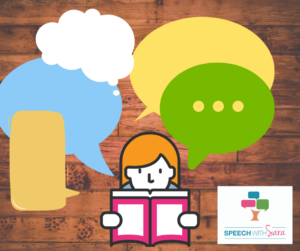 after:
after:
• interacting with the child
• learning more about family dynamics
• learning about the student’s work habits, motivation and response to clinician feedback
• determining the severity of the impairment
Each one of these factors play an important role in helping a child learn or remediate a skill that either never developed or was lost along the way.
SLP-Client Relationship
The interaction and relationship between a speech therapist and a client is important. Before a client is able to learn/remediate an impaired skill, trust needs to be established. This is especially true for children. They need to understand the speech therapist is going to be supportive and helpful and that therapy is a place in which they can practice safely. This means the child can make mistakes, acknowledge when a certain skill is difficult and/or verbalize frustration during the process without judgement.
Family Involvement
The family dynamic is equally important. Families need to be involved with speech therapy. If not directly in sessions, as this may not always be feasible or desired by the client, at least for carryover support and practice beyond the actual therapy session. This might mean practicing a word over and over again each night before bed or practicing descriptive sentences while grocery shopping. The the more practice a child is able to incorporate into their daily lives, the speedier the overall therapy process is likely to be.
That being said, if the practice at home is with incorrect productions, it will not help. This is where it becomes important for a parent to be an extension of the speech therapist. Parents need to provide their children with accurate feedback when they are practicing–not sympathy feedback. The more a skill is practiced incorrectly, the longer it will take to remediate. For example, if a child is working on articulation of the /r/ sound and incorrect productions are reinforced at home by a parent or relative who is feeling badly for the child, it will take that child significantly longer to reach the goal of consistently producing /r/ correctly.
Motivation & Work Habits
Work habits, motivation and response to clinician feedback by a client also impact speech therapy. I believe clients should know their goals in speech therapy. This helps clients understand what is expected. Children who are aware of their speech therapy goals, want to improve the deficit(s) and complete tasks in therapy without hassle are likely to make faster progress than those who attempt to avoid activities, avert attention to something else and/or those who simply don’t believe they should be in speech therapy. If a client does not recognize the deficit, the goal of speech therapy at that point is to heighten awareness and once that’s achieved, to improve the skill.
Severity Impact
Severity is the other major factor in the length of time speech therapy will take to have an impact upon a client. Generally, the more severe, the lengthier the therapy process will be. There are exceptions of course.
As I shared above, speech therapists can make an educated guess about the length of time the therapy process will take but there are a few more pieces of the puzzle that determine how quickly speech therapy becomes effective. These are the unknown pieces that speech therapists cannot factor into their educated guess until they’ve begun working with the client.
These include:
• attendance
• where speech therapy falls on the family’s list of priorities
• follow through on home practice
Attendance Matters
Inconsistent attendance is prohibitive to steady progress and can lead to regression. This doesn’t mean that a child can never be sick or an adult never has conflicts. Life happens, however, it means that speech therapy cancellations should be the exception not the norm. It should not be cancelled or skipped regularly. If it is, progress will likely be negatively impacted and slowed at a minimum. This means keeping appointments even when children are ‘not in the mood,’ having a bad day or a sibling is sick. Keeping up on therapy appointments holds the client accountable simply by expectation. It sends the message indirectly that speech therapy is important. This leads to the next point: the priority of speech therapy.
Speech Therapy is Hard Work
Working to improve speech sounds is not easy. Trying to build/comprehend/express language requires effort. Voicing a sound a child never knew existed is a complicated, non-tangible concept. Using multiple word utterances is a challenge. Eliminating distractions to improve auditory attention requires awareness and concentration. Speech therapy–no matter the goals–is a lot of hard work.
On the surface it can look like play. For the youngest of children, it involves toys. For older children it involves games. Speech therapy lesson planning involves the combination of implementing research based therapy techniques and strategies with toys/games/literacy materials that are not only the most natural way to learn but also of interest to children. While it appears as playing games, be assured, children are putting forth a lot of effort and energy to work on their goals. Having fun is a bonus side effect of successfully marrying research and materials to spark numerous practice opportunities for children during speech therapy.
In speech therapy, clients are working to acquire a skill they did not learn inherently or to recoup a skill lost. Learning the skill is the first step. Implementing the skill is the second step. Practicing the skill to master it is the third step. Doing this is not easy. It requires effort, awareness, concentration, sometimes a change in behavior/movement, and more. It takes time. It takes patience.
Home Practice is Critical
The last unknown factor that impacts the length of time speech therapy will take to have an impact is carryover practice. That is the time a child spends working on the target skill outside of therapy. This is when parents and other care givers play a vital role to helping further progress. When speech-language pathologists assign ‘homework’ or home practice, the goal is to start eliciting the skill in more natural circumstances than the therapy room. Once that starts happening (i.e. the child starts producing the /s/ sound while driving to the bank spontaneously), progress generally speeds up and mastery of the skill is nearing. I assign home practice once the student is achieving the skill successfully in therapy. This ensures the child is not practicing the skill incorrectly, which will then stall progress and lengthen the need for therapy. If a family does not follow through on practice as requested by the speech therapist, it only lengthens the amount of time speech therapy is necessary. By following up on the home practice, it reinforces importance of speech therapy and the goal(s) to the child. It also provides children the most natural opportunities to practice their target skill–in every day life.
After all, the overall goal of any speech therapy is to help a person communicate independently in their daily life. The road there is important. Sometimes it’s winding and scenic and other times its clear and ordinary.
To reach and master speech therapy goals, it takes time. It requires patience. It requires practice. It should take priority.
School vs. Private Speech Therapy: What’s the Difference?
Speech-lan guage pathologists work in a variety of settings. Schools, hospitals, private clinics, rehabilitation centers, long-term residential centers, dementia units, early intervention outreach programs, accent modification businesses, autism-focused centers, mobile swallow study businesses and more. The wide-variety of workplaces for speech therapists is reflective of the large scope of practice outlined by the American Speech-Language-Hearing Association.
guage pathologists work in a variety of settings. Schools, hospitals, private clinics, rehabilitation centers, long-term residential centers, dementia units, early intervention outreach programs, accent modification businesses, autism-focused centers, mobile swallow study businesses and more. The wide-variety of workplaces for speech therapists is reflective of the large scope of practice outlined by the American Speech-Language-Hearing Association.
Most speech therapists become more specialized in particular areas of practice based on their own interests and professional experience. The scope and variety within the field is part of what made it so attractive to me. The same, however, is why most people have a limited idea of the areas in which speech-language pathologists work.
When considering speech therapy for your child, it can be overwhelming to understand the options.
First of all, speech therapy is a medical service–even in schools. We are professionally trained medical specialists whose area of expertise involves the anatomy from the neck up. We address swallowing & feeding disorders, neurological impairments, oral-motor dysfunction and head & neck injuries, all of which can impact communication skills.
Frequently, parents ask me the difference between receiving speech therapy services at school and receiving it in a clinical setting. I’ve worked in and enjoyed both settings.
Public School Speech Therapy
Public school districts are a wonderful resource. Speech therapy services are available to residents who live within their district boundaries free of charge if a child qualifies based on testing performed during an evaluation.
The most obvious benefit is that there is no financial impact upon the family. In order to qualify for services in public schools, the issue of concern must have a negative impact upon the child’s academic performance. For the youngest of children (those not yet school-aged), qualification is based on whether the child is meeting their developmental milestones for speech and language.
If a student qualifies for services, the second benefit is that therapy happens during the school day. Once an IEP (Individualized Education Plan) is in place, speech therapy is worked into the child’s schedule in conjunction with the rest of their academic rigor. This provides the great convenience of not having to make yet another appointment or commitment beyond school hours each week.
Generally in schools, students are seen in groups for speech therapy. Caseloads vary significantly district-to-district and state-to-state. In Michigan, the recommended limit is 60 students. It is not law but simply a recommendation. This means one speech therapist may have upwards of 60 (or possibly more) students to treat each week based on the goals and time requirements outlined in the IEP.
For some students, groups are very beneficial and allow indirect learning from peers, comfort in knowing they have peers who also receive speech therapy, and informal practice on pragmatics, or the social aspects of communication such as turn-taking, using polite language, etc. For others, working in a group can be highly distracting, demotivating and result in less progress on speech and language goals.
Speech therapy services are also available in clinical settings, such as outpatient services through a hospital provider, or through a private practioner.
Clinical Setting Speech Therapy
Similar to schools, children qualify for services in a clinical setting based on their performance during an evaluation. Often the same or similar tests or battery of tests will be given in both schools and clinical settings. An immediate difference between the two settings involves qualification for services. A child can qualify for services clinically but may not qualify in schools. This touches on that point previously mentioned: the delay/impairment must negatively impact academic performance in schools.
This is one advantage of seeking speech therapy from a clinical provider. A child who does not qualify in schools may still need help and could receive it in a clinical setting.
In a clinical setting, therapy is provided on a one-to-one basis unless the session is specifically outlined as a group session. This means the speech therapist can customize materials and lesson-plans specific to that child. Additionally, this allows the child more opportunities each speech therapy session to practice the target skills.
For example, a child who is working on the /r/ sound. In a school session, which is likely a group, the child might have 10 turns in 30 minutes while two other students also had 10 turns during the same 30 minutes. In a clinical setting, the same child would have 30 opportunities in 30 minutes.
Speech therapists in a clinical setting are able to provide specific feedback to parents immediately after a session and to implement a home practice plan that mimics the strategies being using in therapy. School speech therapists can do this as well, but it is less likely given the caseload volume. When I was in schools, I had the best intentions of sending home carryover work and sometimes I did but not as much as I would have liked.
In a clinical setting, services are paid either by health insurance if any is covered (most plans vary wildly in coverage for this type of therapy) or privately. This obviously has a financial impact upon the family. There is also a reoccurring time commitment for families.
Prevalence & Time in Therapy
Ultimately, the difference between the two settings comes down to how long it will take to resolve the speech and/or language deficit. Generally, in one-on-one therapy, clients are able to make progress more quickly because of the increased practice opportunity, the specificity of lesson plans and therapy methods implemented, and the implementation of home practice/strategies to encourage carryover of the target skill beyond the therapy room. So instead of years of speech therapy, it could be one year or several months.
Additionally, children can be treated in speech therapy both in school and in a clinical setting. This has potential to be beneficial to the child if the team of therapists are collaborating and communicating to share successes and reinforce successful strategies.
In choosing where to seek help for speech and language deficits for a child, it’s important for families to consider all of the factors. Ultimately, the child needs the option that will happen.
Seek out speech therapy services as soon as you suspect there is an issue. According to the National Institute on Deafness and Other Communication Disorders, 1 in 12 children ages 3-17 had disorders related to voice, speech, language or swallowing in 2016. The prevalence of speech sound disorders (articulation and phonology) is 8-9 percent of young children and approximately 5 percent of first graders.
Identify the Signs campaign by ASHA provides information on developmental speech and language milestones to help parents, or contact Speech With Sara LLC with additional questions.
Journalism & Speech Therapy: They’re Not So Different
I’m a speech-language pathologist and a former journalist. I love both. I’m fortunate in that respect. I choose two careers that have allowed me to work with people and two careers that offered me the chance to help others.
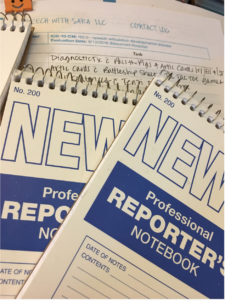 Frequently when I encounter a conversation about my professional path, people question why I made such a significant change from journalism to speech-language pathology. It always gives me a bit of chuckle. While others view the two professions as vastly different, I can likely list a counterpoint of why they are alike.
Frequently when I encounter a conversation about my professional path, people question why I made such a significant change from journalism to speech-language pathology. It always gives me a bit of chuckle. While others view the two professions as vastly different, I can likely list a counterpoint of why they are alike.
Both involve interacting with people. Both involve communication. Both involve communication that is strained. In journalism, I often communicated with people in crisis who were not experiencing their best moments in life. In speech therapy, I communicate with people who also may be in crisis for different reasons–maybe they are recovering from a stroke or a traumatic brain injury; or they are learning how their child’s communication skills are not advancing as expected; or they are dealing with talking with a stutter.
Both also involve helping others and promoting change. In journalism, my favorite stories were those that exposed a problem (people were being harmed/treated unfairly). Such stories often impacted change for the better through improved policies/procedures to stop whatever the injustice may have been. Sometimes this was on a small scale and sometimes it was on a much larger scale. It felt good to know my research and writing could help others. In speech therapy, my favorite part is watching the proverbial light bulb go on with my clients–that moment when everything I’ve taught and they’ve learned comes together and progress is made. It’s motivating to both of us and it promotes a positive change in their life.
Both also involve research. I love learning. I picked two careers that allowed me to continue learning each and every day. In journalism, I researched topics I might not have otherwise in preparation for interviews, stories and projects. In speech therapy, I research new evidence-based techniques, the latest studies that are happening in the field and about child development and the constantly changing legislation that impacts service-delivery and coverage. I love learning from others, which is something I have been able to do in both careers as well. As a journalist, I interviewed experts frequently. As a speech-language pathologist, I have built several networks of other speech therapists as well as related professions, such as occupational therapists and child psychologists. These networks help me improve my therapy skills as well as techniques and lesson-planning.
Both require a lot of note-taking and writing. In journalism, putting together all of the information gathered for stories (research + interview information) required organization and writing. In speech therapy, there is data collection during sessions (anecdotal + tracking correct/incorrect responses), lesson-planning and therapy notes that must be written afterward to provide information about the client’s performance and outcome. There are speech and language evaluation reports to write; progress notes; and exit paperwork when therapy has been successful and the client is ready to graduate.
I could continue to share more reasons, but I think this supports my point. Journalism and speech therapy are not so different, contrary to popular belief.
Tips to Promote Language through Reading
Reading is one of my favorite ways to spend time. That includes reading myself as well as reading to my children. Not only do I enjoy the story but the extra snuggles are wonderful too!
Reading aloud to children is one of the best ways to promote language development. It builds vocabulary. It teach es sequencing (beginning/middle/end; problem-solution-result). Syntax. Word structure. Body language. Intonation. Rhyming. The list could go on and on. It also helps children learn their sounds to develop articulate speech.
es sequencing (beginning/middle/end; problem-solution-result). Syntax. Word structure. Body language. Intonation. Rhyming. The list could go on and on. It also helps children learn their sounds to develop articulate speech.
I plan literacy-based sessions frequently, especially for the youngest of my clients. It provides a context to whatever we may be working on in speech therapy and gives them practice with their skill in a real-life occurrence. This helps with carrying the skill we practice in speech therapy to other areas of life, such asat home, in the classroom, in the car, talking to peers at lunchtime and pretty much everywhere.
Tip 1: Be animated
Get into character. Emphasize the right tone and cadence of the story. Listeners find this more engaging and they are learning more about language and communication. They can learn about sarcasm and humor. They also learn about communication presentation, which we all know makes a huge difference in pretty much anything we do.
Tip 2: Read and re-read
Don’t be afraid to read a story over and over again. All the research shows re-reading greatly enhances a child’s comprehension, increases vocabulary, improves reading/story fluency, advances decoding skills and allows them to learn new elements of the story they may not have caught the first time through.
Tip 3: Take the time to talk about it
Have discussions about the story, the characters, the words, the emotions, the humor, etc. This is a big part of where vocabulary development happens. Answer your child’s questions to enhance their understanding. Expand on your answer to give another context or example of when a particular word would be used. Explain the character’s perspective and why he or she might be feeling a particular way. Relate that feeling to your child and a time when they felt the same emotion. Build the connections between the storyline and their life.
When I plan literacy-based therapy sessions, I incorporate toys and/or visuals for the students to interact with after the story. The picture here includes a recent sensory bin I created for one of my favorite books, Little Blue Truck. The theme of the book is about being 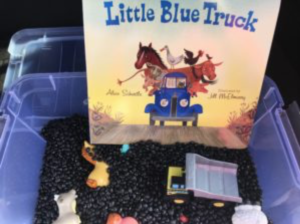 kind and respectful to everyone. We discuss the characters (a bunch of farm animals, an initially impatient and rude dump truck, a friendly pickup truck), the actions of the dump truck and their impact on him and the farm animals, the ultimate outcome of working together to achieve more. It’s loaded with common sight words but also has a variety of more spicy vocabulary to introduce and discuss.
kind and respectful to everyone. We discuss the characters (a bunch of farm animals, an initially impatient and rude dump truck, a friendly pickup truck), the actions of the dump truck and their impact on him and the farm animals, the ultimate outcome of working together to achieve more. It’s loaded with common sight words but also has a variety of more spicy vocabulary to introduce and discuss.
I’d love to hear about what books are favorites in your house. Please share below. I’m always looking for new books!
Have questions about speech and language development or literacy, contact Speech With Sara at 313-815-7916 or by email. Speech With Sara offers individual therapy for speech-sound disorders, early childhood language delays, literacy & language deficits and orofacial myofunctional disorders.
Nice to Meet You!
Let me take a moment to introduce myself.
I am a mom, a speech-language pathologist, a former journalist, a wife, a daughter, a sister and an avid reader to name a few of the roles/titles associated with me. I’m a multi-tasker who enjoys the hustle & bustle of everyday life. I’m an active person and enjoy outdoor activities including running, biking, swimming and hiking as well as my own backyard. I love listening to music, reading a good book or the latest research, getting together  with friends and playing games and reading with my children. I also love to travel.
with friends and playing games and reading with my children. I also love to travel.
I’m excited about my newest professional adventure–my own private practice. I am eager to share ideas, information and skills with my clients as well as with parents who may have questions about speech and language development or families dealing with rehabilitation of a loved one following a neurological change.
Communication has been the theme of my professional life for more than 15 years. I began in daily newspapers as a reporter and continued in the field as a journalist until earning my masters in speech-language pathology. The two professions seem vastly different, I’m told frequently, but I don’t think so. I’ll explain that in my next post.
It’s fair to say that I’m a people-person. I enjoy meeting new people and learning about them, their culture, their lives, their experiences. It should come as no surprise then that as a speech-language pathologist, or SLP, I love getting to know my clients and their families. This connection is invaluable to the outcome for the client, and quite frankly, enjoyable. I’ve always enjoyed meeting new people. I make friends everywhere I go and am always learning from them. This has made me a better person overall, and a better speech-language pathologist at that.
As I get my blog started–the marriage of my two careers (writing about speech-language development)–I’d love to get ideas from you. What do you want to know about related to speech and language development or rehabilitation? about speech therapy? Please share your thoughts in the comments below.
Nice to meet you!

